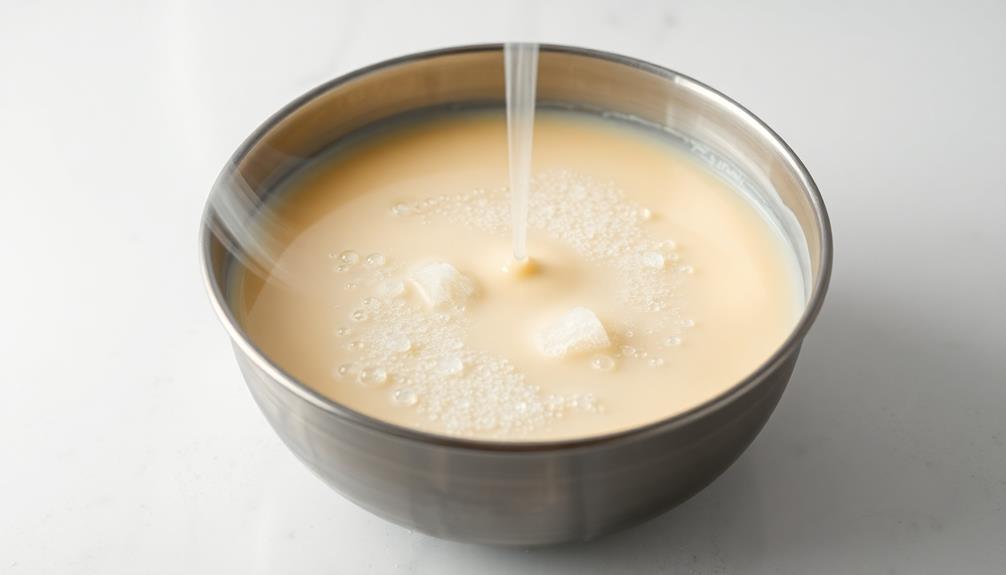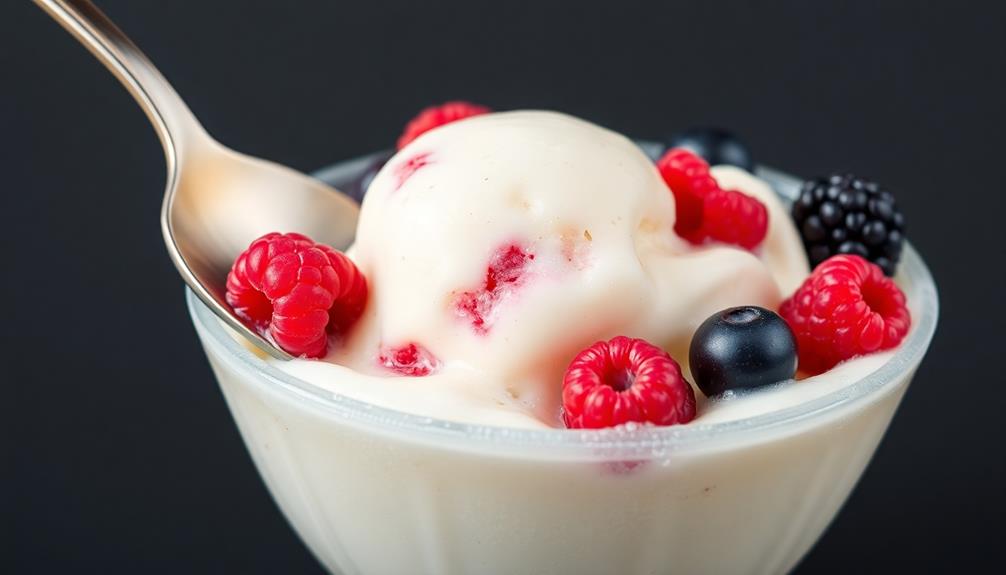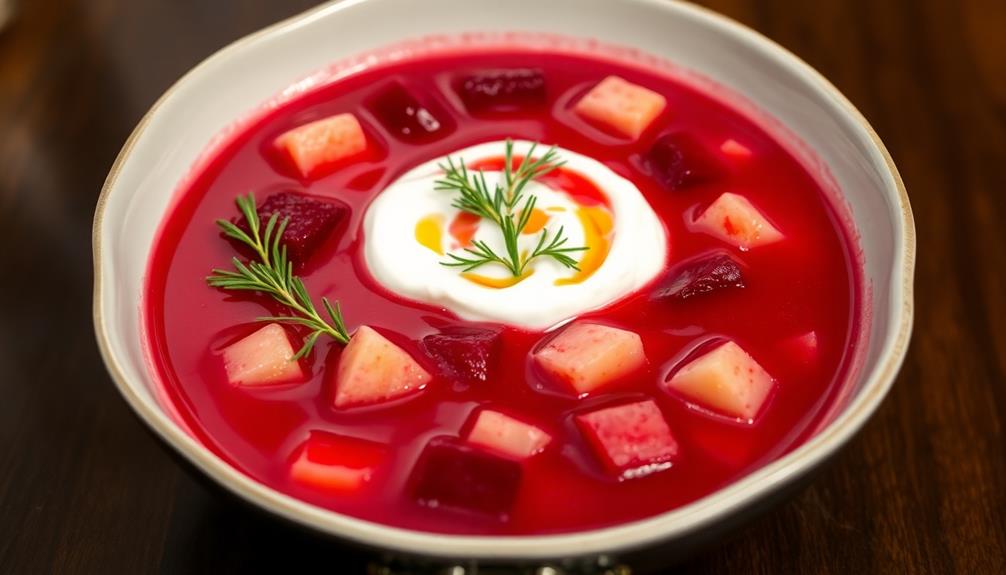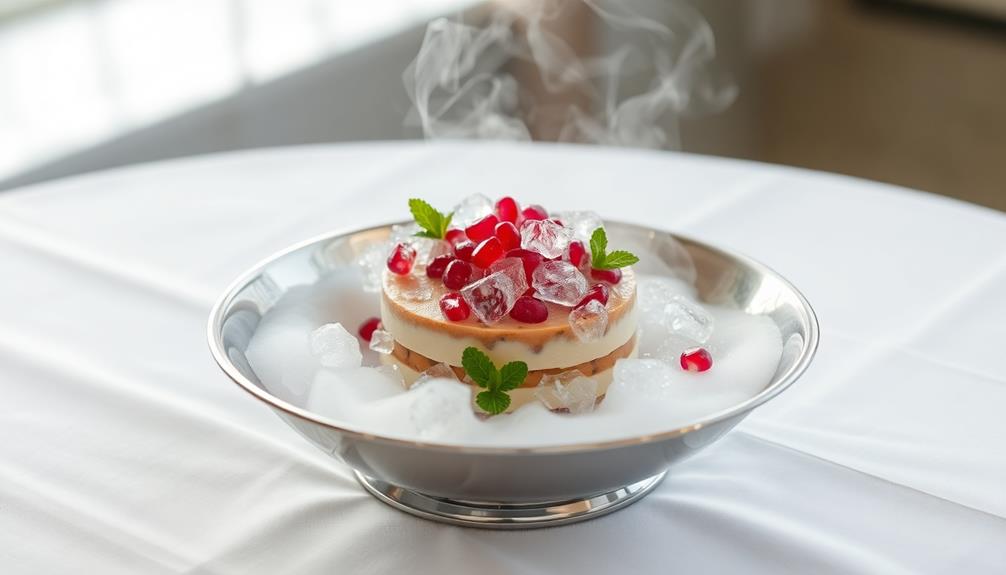Get ready to unlock a world of culinary magic with liquid nitrogen! This extraordinary ingredient lets you create incredible frozen desserts, foams, and more – right in your own kitchen. You'll be amazed as you watch ingredients instantly transform, thanks to the extreme cold of liquid nitrogen. Don't worry, it's safe to use with the right precautions. Just be sure to wear gloves and goggles, and work in a well-ventilated area. Soon, you'll be whipping up showstopping nitrogen-frozen treats that will wow your friends and family. The possibilities are endless – let your imagination soar!
Key Takeaways
- Liquid nitrogen enables rapid freezing of ingredients, creating unique textures and presentations that enhance flavors by preserving freshness.
- Safety is paramount when using liquid nitrogen; proper precautions, such as wearing insulated gloves and eye protection, must be observed.
- Precise measurement of ingredients is crucial for successful cryogenic cooking techniques, ensuring consistent and desirable results.
- Liquid nitrogen can be used to create a wide variety of frozen desserts, foams, and mousses, as well as instantly freeze fruits and vegetables.
- Experimenting with liquid nitrogen encourages culinary creativity and innovative dish development, expanding the possibilities of traditional cooking methods.
History
The origins of cooking with liquid nitrogen can be traced back to the mid-20th century, when scientists and chefs alike explored the unique culinary possibilities offered by this ultra-low temperature substance.
They discovered that by immersing food in liquid nitrogen, which is around -320°F (-196°C), they could create incredibly fast freezing effects, leading to the formation of smooth, creamy textures and unexpected shapes.
This revolutionary technique, known as "molecular gastronomy," quickly gained popularity among adventurous cooks and food enthusiasts.
As the years passed, more and more chefs experimented with liquid nitrogen, finding new and innovative ways to incorporate it into their dishes. From frozen cocktails to flash-frozen ice creams, the use of this chilly ingredient became a hallmark of modern, high-tech cuisine.
Today, cooking with liquid nitrogen is no longer just for professional kitchens.
Home cooks can now explore the wonders of this scientific approach to food, opening up a world of culinary possibilities right in their own kitchens.
Recipe
Liquid nitrogen is a versatile tool that can be used to create unique and visually stunning culinary creations. When handled with care, it can transform ordinary ingredients into extraordinary dishes.
The key to successful liquid nitrogen cooking is maintaining precise temperature control and safety protocols. Proper insulation and protective gear are essential to prevent frostbite and other injuries. Experimentation and a bit of culinary creativity can yield spectacular results.
Ingredients:
- 2 cups heavy cream
- 1 cup whole milk
- 1/2 cup granulated sugar
- 1 vanilla bean, split lengthwise
- 1 cup fresh berries (such as raspberries or blueberries)
Instructions:
In a medium saucepan, combine the cream, milk, and sugar. Scrape the seeds from the vanilla bean and add them to the saucepan, then add the bean pod as well.
Heat the mixture over medium, stirring occasionally, until the sugar has dissolved and the mixture begins to steam, about 5 minutes. Remove from heat and let cool to room temperature.
Carefully pour the cooled mixture into a metal bowl or baking dish. Slowly pour liquid nitrogen over the top, stirring gently, until the mixture is frozen, about 10-15 minutes. Scoop the frozen custard into bowls and top with fresh berries.
When working with liquid nitrogen, always exercise extreme caution. Ensure adequate ventilation, wear insulated gloves, and work in a well-lit area.
Introduce the liquid nitrogen slowly and in small amounts to avoid explosive boiling. The rapid freezing caused by the nitrogen can create a striking visual effect, but should be monitored closely to prevent over-freezing.
Cooking Steps
Obtaining liquid nitrogen safely is key.
Measure your ingredients precisely to ensure the best results.
Rapidly freeze your ingredients in the chilly nitrogen, then serve them immediately while they're still frozen.
Repeat the freezing process as desired to create delightful, icy dishes.
Step 1. Obtain Liquid Nitrogen Safely

When handling liquid nitrogen, safety should be your top priority. This super-cold liquid can cause serious damage if not used correctly.
First, always wear insulated gloves and eye protection to shield yourself from the extreme temperature. The gloves will prevent your skin from sticking to the liquid, and the goggles will keep your eyes safe.
Next, work in a well-ventilated area. Liquid nitrogen evaporates quickly, which can displace oxygen and lead to suffocation. Make sure there's plenty of airflow around you.
Finally, never seal liquid nitrogen in a container – the expanding gas can cause an explosion. Slowly pour the liquid into your cooking vessel, and use it right away.
With these simple safety steps, you'll be able to enjoy the magical effects of liquid nitrogen in your kitchen. Just remember to stay cautious and have fun experimenting!
Step 2. Measure Ingredients Precisely

With liquid nitrogen at the ready, precision is key when measuring your ingredients. Since this powerful coolant freezes everything it touches, you'll need to work quickly and accurately.
Start by using a small digital scale to weigh out your food items – this ensures you get the exact amount needed for your recipe. Don't guess or eyeball the measurements; be sure to follow the instructions closely.
For liquids, use a clear measuring cup and double-check the markings. It's easy to overfill, so go slowly and keep an eye on the level.
Solid ingredients like fruits or vegetables should also be measured precisely, either by weight or volume. Take the time to chop or slice them evenly.
Careful measuring means your liquid nitrogen creations will turn out perfectly every time. When you can control the quantity of each element, the results will be consistently amazing.
Pay close attention and you'll be making showstopping frozen desserts and savory bites in no time!
Step 3. Rapidly Freeze Ingredients in Nitrogen

Carefully lower the measured ingredients into the pool of liquid nitrogen.
You'll be amazed as the cryogenic temperatures instantly freeze everything! The nitrogen boils violently, creating a dramatic, misty effect. It's like magic.
Once the ingredients are frozen solid, you can remove them from the nitrogen and start shaping them.
Get creative – you could make bite-sized ice cream balls, shards of frozen fruit, or even a nitrogen-frozen mousse. The frozen treats will have an incredibly smooth, creamy texture.
Just be careful when handling the super-cold nitrogen – it can damage your skin if you're not wearing gloves.
As the nitrogen evaporates, it forms a cloudy vapor that swirls around your work area. This adds to the excitement and wonder of cooking with liquid nitrogen.
Have fun experimenting, and be amazed by the incredible results you can achieve.
Step 4. Serve Immediately While Still Frozen

As soon as you've shaped your frozen creations, it's time to serve them. The key is to work quickly, as the liquid nitrogen does its job – keeping your ingredients frozen solid.
Grab your platter or plate and arrange the shapes you've carefully molded. Whether you've made spheres, cubes, or unique designs, they'll look stunning sitting there, just waiting to be enjoyed.
Don't let them sit for long, though. The frozen treats won't stay that way for very long once they're out of the chilly nitrogen bath. Serve them immediately, before they start to melt.
Your guests will be amazed as they dig in, experiencing the surprising crunch and intense flavors. The contrast of the icy exterior and the soft, creamy interior is truly delightful.
Be sure to warn everyone to eat quickly, as these frozen delights won't last long at room temperature. Savor every bite and enjoy the extraordinary results of cooking with liquid nitrogen!
Step 5. Repeat Freezing as Desired

Having shaped your frozen creations, you can now repeat the freezing process as desired. Simply return the items to the liquid nitrogen and let them chill once more. This allows you to build up layers of frozen goodness, creating truly unique desserts and treats.
Don't be afraid to experiment – try freezing the same item multiple times to see how the texture changes. The more you freeze, the more intense the cold bite will become. You might end up with a shatteringly crisp outer layer surrounding a soft, creamy center.
Or perhaps you'll achieve an icy, granita-like consistency throughout. The options are endless!
Just be sure to work quickly, as the liquid nitrogen evaporates rapidly. Have fun playing with different shapes, sizes, and flavors. With a little practice, you'll be whipping up imaginative frozen masterpieces in no time.
Remember to serve them immediately for the full frozen experience.
Final Thoughts
Cooking with liquid nitrogen has opened up a world of culinary possibilities, pushing the boundaries of traditional cuisine. From creating frozen treats to enhancing the flavors of everyday dishes, the versatility of this unique ingredient is truly remarkable.
By now, you've learned how to expertly handle liquid nitrogen and apply it to a variety of recipes, unlocking a new realm of molecular gastronomy right in your own kitchen. Molecular gastronomy techniques allow you to manipulate the physical and chemical properties of ingredients, creating innovative and visually stunning dishes. With your newfound skills, you can impress your friends and family with foams, gels, and other textures that were once only found in high-end restaurants. The possibilities are endless as you continue to experiment and push the boundaries of traditional cooking.
As you continue on your culinary journey, remember to always prioritize safety and experiment with caution. Embrace the sense of wonder and discovery that comes with pushing the limits of traditional cooking methods.
Who knows what delightful and unexpected creations you'll dream up next? The possibilities are endless when you harness the power of liquid nitrogen.
Frequently Asked Questions
Is It Safe to Use Liquid Nitrogen at Home?
Using liquid nitrogen at home can be risky. It's extremely cold, so you'll need proper safety gear. Avoid inhaling vapors, and work in a well-ventilated area. Proper precautions are essential to prevent injuries when handling this cryogenic liquid.
How Long Does the Food Stay Frozen When Using Liquid Nitrogen?
When using liquid nitrogen, the food stays frozen for a short time. The duration depends on the food's volume and the amount of liquid nitrogen used. The food will quickly thaw once the nitrogen evaporates.
Can I Substitute Other Ingredients for the Ones in the Recipe?
You can substitute other ingredients, but it depends on the recipe. Consider factors like texture, flavor, and cooking time. Experiment cautiously, as substitutions may impact the final dish in unexpected ways. Always prioritize food safety when making changes.
How Do I Store Leftovers From Liquid Nitrogen-Cooked Dishes?
You can't store leftovers from dishes cooked with liquid nitrogen. They'll quickly lose their unique texture and flavor. Liquid nitrogen dishes are best enjoyed immediately after preparation for the best results.
Can I Use Liquid Nitrogen to Make Ice Cream at Home?
You certainly can use liquid nitrogen to make ice cream at home. The extreme cold allows for rapid freezing, creating a smooth, creamy texture. Just be sure to take proper safety precautions when handling the liquid nitrogen.









